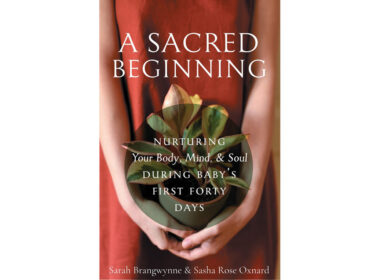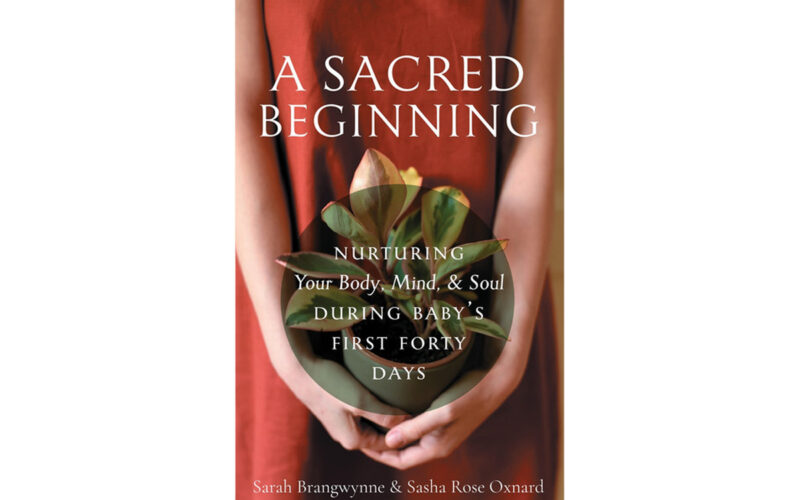When it comes to literature on motherhood and postpartum care, the figurative bookshelf is surprisingly sparse. Narrow it down to Christian perspectives, and it shrinks even more. Take it one step further—into the realm of Orthodox Christianity—and you’re left with just a single book dedicated specifically to this tender season: A Sacred Beginning: Nurturing Your Body, Mind, & Soul During Baby’s First Forty Days.
To say this book was a long time coming for this audience is an understatement. Luckily, Sarah Brangwynne and Sasha Oxnard rose to the challenge and created a book that truly nourishes the body, mind, and soul during one of the most drastic transitions in a woman’s life.
I’ve been an Orthodox Christian my whole life, my husband is an Orthodox priest, and I am a mother to four children. I wish I had had this book during my primero postpartum. Even so, I believe there is much to gain from reading this book, whether it’s your first or tenth baby, and even if you are not an Orthodox Christian.
Sara Brangwynne is an Orthodox Christian, wife, mother, and therapist. As a licensed professional counselor and board-certified dance/movement therapist specializing in reproductive health, she has ample knowledge navigating postpartum alongside mothers.
Sasha Rose Oxnard is an Orthodox Christian, wife, and mom. She is a family doctor who specializes in prenatal care and pediatrics, which allows her to bring evidence-based and practical knowledge to her writing. Her personal experience as a mother adds to her expertise.
Both Brangwynne and Oxnard integrate their Orthodox Christian faith into the book, including the wisdom of Scripture and the teachings of the Church Fathers.
Who is the intended audience of A Sacred Beginning?
This book’s ideal reader is an Orthodox Christian woman preparing for postpartum or even one who stumbles upon it shortly after birth. Brangwynne and Oxnard also discuss its relevance for mothers who have adopted a child as they navigate the transition to child rearing. The authors make a note that though this book is written from an Orthodox Christian point of view, they believe that all Christian women may benefit from it.
What are the main content areas of A Sacred Beginning?
A Sacred Beginning starts with a brief introduction on how this book can be applied to a new mother’s life. They take into account the varying backgrounds from which readers may come, but connect the reader to the single truth that God created each of us to grow, nourish, and raise a baby in our arms–including if we come to motherhood through adoption.
The book is divided into 10 parts, including chapters on the Golden Rules of Motherhood, loss, and recommended resources. In parts two through nine, the chapters follow the teachings of St. John Climacus, often referred to as St. John of the Ladder, who taught about 30 different steps, which are “the ‘Divine Model’ for the faithful Christian.” Each step is a different virtue to emulate or passion to overcome in the Christian life.
Brangwynne and Oxnard draw a connection to the first 40 days postpartum with each virtue or passion that St. John describes. The topics discussed include: Renunciation, Detachment, Repentance, Meekness, Patience, Worry, Gluttony, and Chastity, just to name a few. By breaking down the first forty days in this way, the authors draw attention to the fact that postpartum isn’t just about physical recovery, it’s also the mother’s opportunity to find spiritual connection to God, who gave them their baby in the first place. They emphasize the holy work that is done during this time and that the mother should do her best to take it seriously.
Postpartum isn’t just about physical recovery, it’s also the mother’s opportunity to find spiritual connection to God, who gave them their baby in the first place. They emphasize the holy work that is done during this time and that the mother should do her best to take it seriously.
Further, each chapter is broken down into two main parts: “For the Soul” and “For Mind & Body”, which break down the specific “step” from St. John. For example, when “Gluttony” is discussed, the “for the soul” section talks about how gluttony is a passion that can lead us to dependence on something other than God. The “for the body” then discusses the importance of nourishment postpartum. In some chapters, the authors include journal prompts to encourage the reader to think a little deeper or take more time to process the information.
Each chapter has multiple spiritual quotes to ponder or pray on, as well as personal reflections from either Brangwynne or Oxnard. They also quote many Orthodox mothers expanding on the myriad of experiences one may have in the 40 days postpartum. Each chapter takes only 10 or 15 minutes to read, and is easily broken down into 5 minute chunks if need be.
Strengths of A Sacred Beginning
A Sacred Beginning does a wonderful job of highlighting the monumental spiritual changes that come in the 40 days postpartum. Whereas most of the world glosses over this time because the baby is already born, Brangwynne and Oxnard emphasize that this transition is unlike any other in life, and if a mother takes it seriously, she can enter motherhood with a strong spiritual and physical foundation.
A Sacred Beginning does a wonderful job of highlighting the monumental spiritual changes that come in the 40 days postpartum. Whereas most of the world glosses over this time because the baby is already born, Brangwynne and Oxnard emphasize that this transition is unlike any other in life, and if a mother takes it seriously, she can enter motherhood with a strong spiritual and physical foundation.
In the Orthodox Christian tradition, mothers stay away from the Church for the first 40 days postpartum. Though this may seem antiquated or isolating, it’s a tradition that the Church has kept sacred since the Old Testament. As Christians, we imitate the Virgin Mary and her time that she rested after Jesus Christ was born, as seen in Luke 2:22-23. When we return to Church, it’s with prayer, thanksgiving, and celebration.
But, in the time away, it can be challenging to be away from the sacred services. That’s why I personally appreciated this book so much. It offers spiritual comfort and friendly commiseration during a physically and emotionally exhausting time. Because of the chapter length, it’s just enough to settle in with a nursing or sleeping baby and soak up not only spiritual advice, but also practical wisdom applicable to what you may be experiencing on that particular day.
It offers spiritual comfort and friendly commiseration during a physically and emotionally exhausting time. Because of the chapter length, it’s just enough to settle in with a nursing or sleeping baby and soak up not only spiritual advice, but also practical wisdom applicable to what you may be experiencing on that particular day.
Although this book doesn’t address a lot of the physical changes happening during postpartum, it brings up some of them (like milk production) that may influence your hormone balance and mood. The authors discuss the importance of rest and proper nourishment for healing, as well as validating the normal fears and anxieties a new mother may have during this time.
Limitaciones o puntos ciegos
As mentioned, while this book does a great job of addressing the spiritual changes one experiences postpartum, it doesn’t go into great detail about the physical changes. The authors touch on some mood irregularities and general physical changes that are expected, but if you want an in-depth understanding of what’s happening to your physiology, look for a different book.
Additionally, this book may be off-putting to women who are not Christian. The Orthodox Christian perspective, which believes that suffering brings fruit and enables us to chip away at our fallen nature, can be hard to swallow in a culture that says pain is always bad and there is no point in suffering.
The verdict: To buy, borrow, or skip A Sacred Beginning: Nurturing Your Body, Mind, & Soul During Baby’s First Forty Days?
If you’re an Orthodox Christian woman, I say this book is a must-have. I wish I had had it with my first baby but even now, as a fourth time mother, I’ve taken away many beautiful reminders and words of encouragement that postpartum can be a time of deep spiritual growth.
If you’re a Christian woman and want a look at what the spiritual side of postpartum care can look like, have an open mind and borrow the book from a friend. You may find that your soul needs the nourishment more than you expected!






